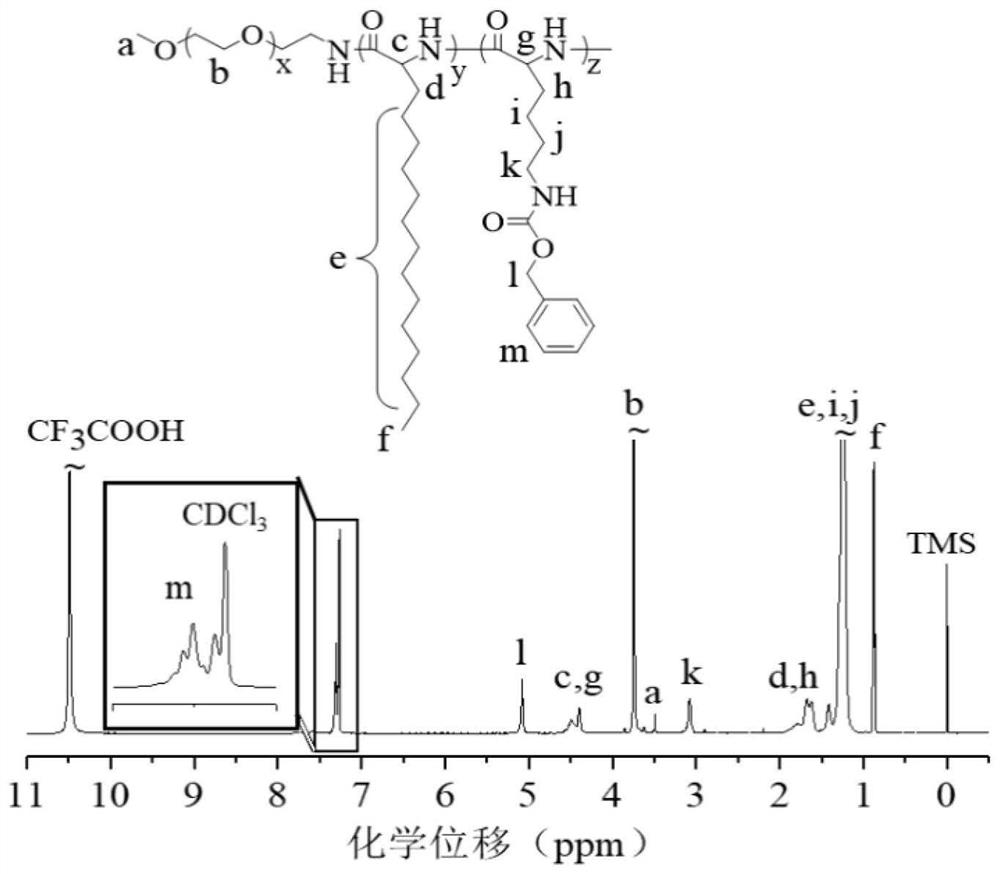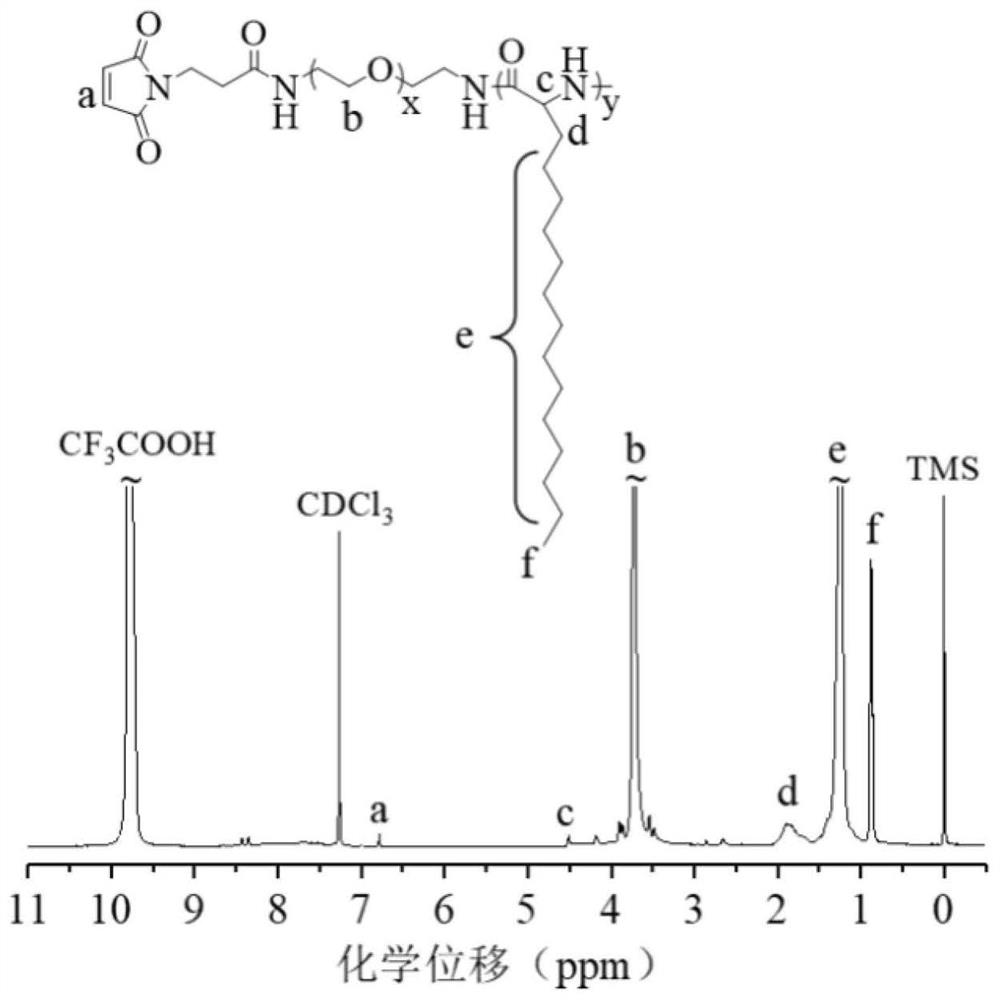A polylipopeptide vesicle with a positively charged inner membrane and its preparation method and application
A polyester and vesicle technology, applied in the fields of polymer materials and applied chemistry, can solve the problems of poor stability and easy dissociation of nanometer systems, and achieve the effects of good stability, high encapsulation capacity and small size.
- Summary
- Abstract
- Description
- Claims
- Application Information
AI Technical Summary
Problems solved by technology
Method used
Image
Examples
Embodiment 1
[0041] Embodiment 1: Synthesis of polyethylene glycol-b-poly(2-aminohexadecanoic acid)-b-poly(L-lysine) (PEG-b-PAPA-b-PLL) triblock copolymer
[0042] The synthesis of PEG-b-PAPA-b-PLL mainly includes two steps. First, under nitrogen, in DMF solution, with PEG-NH 2 Sequential initiation of 2-aminohexadecanoic acid N-carboxylate anhydride monomer (APA-NCA) and ε-benzyloxycarbonyl-L-lysine N-carboxylate anhydride monomer (ZLL-NCA) for macroinitiators PEG-b-PAPA-b-PZLL triblock copolymer was prepared by ring-opening polymerization. The specific synthesis steps are as follows: under a nitrogen atmosphere, a DMF solution of 15.0 mL of APA-NCA (1.04 g, 3.52 mmol) was rapidly added to PEG-NH 2 (0.4g, 0.08mmol) in DMF (4.0mL); after reacting at 35°C for 72 hours, the second monomer ZLL-NCA (0.44g, 1.44mmol) was added, and the reaction was continued for 72 hours. After the reaction, the reaction solution was precipitated in 20 times excess glacial ether for several times, and finall...
Embodiment 2
[0045] Embodiment 2: the synthesis of CPP33-PEG-b-PAPA copolymer
[0046] The preparation of CPP33-PEG-b-PAPA polymer was divided into two steps. First, with Mal-PEG-NH 2 As a macromolecular initiator, APA-NCA ring-opening polymerization is initiated to prepare Mal-PEG-b-PAPA; from its nuclear magnetic spectrum ( image 3 ), its molecular weight can be calculated to be 6.0-11.0kg / mol; subsequently, CPP33-PEG-b-PAPA is prepared by reacting the sulfhydryl group on CPP33 with Mal. From the NMR spectrum of CPP33-PEG-b-PAPA ( Figure 4 ), the characteristic peak of CPP33 (δ6.97) can be found, and the grafting rate of CPP33 obtained by measuring 9,10-phenanthrenequinone is 87%.
[0047] Table 1. Characterization of polymers
[0048]
[0049] a Depend on 1 Calculated by H NMR.
Embodiment 3
[0050] Example 3: Preparation of polylipopeptide vesicles (siPLK1-CPP33-CLP) with asymmetric membrane structure loaded with siRNA
[0051] siRNA-loaded, CPP33-modified vesicles (CPP33-CLP) were prepared by a solvent displacement method. The brief steps are as follows: mix 0.1 mL of a mixed solution containing 20 mol.% CPP33-PEG-b-PAPA and 80 mol.% mPEG-b-PAPA-b-PLL with a concentration of 5 mg / mL and 0.1 mL of siRNA solution, Then it was added dropwise into 0.8 mL of HEPES buffer medium (5 mM, pH 6.8), and then dialyzed in HEPES medium using a dialysis bag with a molecular weight cut-off of 350k to remove unloaded siRNA. The loading capacity (SLC) and loading efficiency (SLE) of siRNA can be measured by NanoDrop UV spectrophotometer. SLC and SLE can be calculated by the following formulas:
[0052] SLC (wt.%)=(mass of siRNA loaded in vesicles / sum of polymer and siRNA mass)×100
[0053] SLE(%)=(mass of siRNA loaded in vesicles / mass of initially added siRNA)×100
[0054] Dyn...
PUM
| Property | Measurement | Unit |
|---|---|---|
| particle diameter | aaaaa | aaaaa |
| degree of grafting | aaaaa | aaaaa |
Abstract
Description
Claims
Application Information
 Login to View More
Login to View More - R&D
- Intellectual Property
- Life Sciences
- Materials
- Tech Scout
- Unparalleled Data Quality
- Higher Quality Content
- 60% Fewer Hallucinations
Browse by: Latest US Patents, China's latest patents, Technical Efficacy Thesaurus, Application Domain, Technology Topic, Popular Technical Reports.
© 2025 PatSnap. All rights reserved.Legal|Privacy policy|Modern Slavery Act Transparency Statement|Sitemap|About US| Contact US: help@patsnap.com



